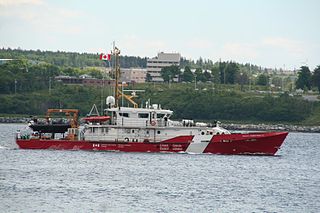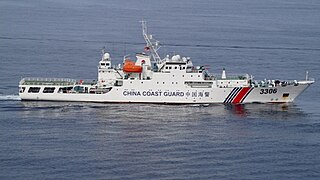Related Research Articles

A coast guard or coastguard is a maritime security organization of a particular country. The term embraces wide range of responsibilities in different countries, from being a heavily armed military force with customs and security duties to being a volunteer organization tasked with search and rescue without law enforcement authority. In most countries, a typical coast guard's functions are distinct from those of the navy and the transit police, while in certain countries they have similarities to both.

A patrol boat is a relatively small naval vessel generally designed for coastal defence, border security, or law enforcement. There are many designs for patrol boats, and they generally range in size. They may be operated by a nation's navy, coast guard, police, or customs, and may be intended for marine, estuarine, or river environments.

The Canadian Coast Guard is the coast guard of Canada. Formed in 1962, the coast guard is tasked with marine search and rescue (SAR), communication, navigation, and transportation issues in Canadian waters, such as navigation aids and icebreaking, marine pollution response, and support for other Canadian government initiatives. The Coast Guard operates 119 vessels of varying sizes and 23 helicopters, along with a variety of smaller craft. The CCG is headquartered in Ottawa, Ontario, and is a special operating agency within Fisheries and Oceans Canada.

The Island-class patrol boat is a class of cutters of the United States Coast Guard. 49 cutters of the class were built, of which 7 remain in commission. Their hull numbers are WPB-1301 through WPB-1349.

The Coast Guard Administration of the Ocean Affairs Council, also known as the Taiwan Coast Guard or R.O.C. Coast Guard, is charged with maintaining law and order, protecting the resources of the territorial waters of the Republic of China (Taiwan), which surrounds Taiwan, Penghu, Kinmen, Matsu Islands, Green Island, Orchid Island, Pratas Island (Tungsha/Dongsha), and Nansha Islands as well as providing a first line of defense along coastal areas against smugglers and illegal immigrants. The CGA is considered a civilian law enforcement agency under the administration of the Ocean Affairs Council of the Executive Yuan, though during emergencies it may be incorporated as part of the Republic of China Armed Forces.

SLNS Vijayabahu (P627) is an Advanced Offshore Patrol Vessel of the Sri Lanka Navy. The ship is named after King Vijayabahu I, the warrior king of the medieval Sri Lanka who founded the Kingdom of Polonnaruwa.

The Maritime Safety Administration of the People's Republic of China is a government agency which administers all matters related to maritime and shipping safety, including the supervision of maritime traffic safety and security, prevention of pollution from ships, inspection of ships and offshore facilities, navigational safety measures, administrative management of port operations, and law enforcement on matters of maritime safety law. It was also responsible for marine accident investigation. It is headquartered in Dongcheng District, Beijing.


CCGS Leonard J. Cowley is an ice-strengthened fisheries patrol vessel of the Canadian Coast Guard. The ship entered service in 1984 and is still currently in service. During the Turbot War, the patrol vessel took part in the detainment of the Spanish fishing vessel Estai. Leonard J. Cowley's home port is St. John's, Newfoundland and Labrador.

The Hamilton-class cutter was the largest class of vessel in the United States Coast Guard until replaced by the Legend-class cutter, aside from the Polar-class icebreaker. The hull classification symbol is prefixed WHEC. The cutters are called the Hamilton class after their lead ship, or the "Secretary class" because most of the vessels in the class were named for former Secretaries of the Treasury.

China Coast Guard, colloquially recognized as the Haijing (海警), is the maritime security, search and rescue, and law enforcement service branch of the People's Armed Police of China. It is currently the world's largest coast guard.

The Hero-class patrol vessels, previously the Mid-Shore Patrol Vessel Project, is a series of nine patrol vessels constructed by Halifax Shipyards for the Canadian Coast Guard. Based on the Dutch Damen Stan 4207 patrol vessel, construction began in 2011 and the first vessel entered service in 2012. The vessels are assigned to the Atlantic and Pacific coasts of Canada, used for coastal patrol duties.

The Ukrainian patrol vessel Sloviansk (P190) was an Island-class patrol boat of the Naval Forces of the Armed Forces of Ukraine. Originally named USCGC Cushing when in service with the United States Coast Guard, the vessel was acquired by Ukraine in 2018 and arrived in Ukraine on 21 October 2019. Sloviansk was sunk in combat on 3 March 2022 by a Russian air-to-surface missile.

USCGC Anacapa (WPB-1335) is an Island-class cutter of the United States Coast Guard. She is based at Petersburg, Alaska and is responsible for law enforcement, search and rescue, and maritime defense.

The Shikishima-class patrol vessel is a class of PLH type patrol vessels of the Japan Coast Guard. In the official classification, Shikishima and Akitsushima are treated as the only ships in their classes, respectively; and Reimei is treated as the lead ship of her class. The Shikishima class was once the world's largest coast guard vessel until it was surpassed by the Chinese Zhaotou-class patrol cutter in 2015.

BRP Gregorio del Pilar (PS-15) is the lead ship of her class of offshore patrol vessel of the Philippine Navy. She is the second ship to be named after Gregorio del Pilar, a Filipino revolutionary general known for his role at the Battle of Tirad Pass. She was originally designated as "PF-15" from 2012 to mid-2016. Then the Navy adopted a new code designation system and she was redesignated as "FF-15". In February 2019, the Navy downgraded the status of the entire class from frigate to patrol ship and redesignated her to "PS-15".

The China Coast Guard operates a variety of vessels for its duties.

The Chiayi-class patrol vessel is a heavy patrol vessel of the Coast Guard Administration of Taiwan. Four ships are planned. All four are planned to be constructed by CSBC Corporation, Taiwan.
References
- 1 2 3 4 5 6 7 8 Martinson, Ryan D. (3 July 2015). "East Asian Security in the Age of the Chinese Mega-Cutter". CIMSEC. Retrieved 25 February 2021.
- 1 2 3 4 5 "江南造船万吨海警船下水涂装完成". eworldship.com. 15 December 2014. Retrieved 11 February 2021.
- 1 2 3 4 Tiezzi, Shannon (24 January 2014). "China To Build World's Largest Marine Surveillance Ship". The Diplomat. Retrieved 25 February 2021.
- ↑ "China Ship-building Industry Corporation to develop first 10,000-ton Coast Guard Ship". Navy Recognition. 22 January 2014. Retrieved 11 February 2021.
- 1 2 3 4 5 Mathew, Arun (8 November 2014). "China to have 10,000-ton coast guard vessel in East China Sea by next year". DefPost. Retrieved 11 February 2021.
- 1 2 3 4 5 6 Gady, Franz-Stefan (13 January 2016). "Beijing Builds 'Monster' Ship for Patrolling the South China Sea". The Diplomat. Retrieved 25 February 2021.
- ↑ Gady, Franz-Stefan (8 May 2017). "China Coast Guard's New 'Monster' Ship Completes Maiden Patrol in South China Sea". The Diplomat. Retrieved 25 February 2021.
- 1 2 "Coast Guard with Muscles". Asian Military Review. 9 September 2019. Retrieved 26 February 2021.
- 1 2 3 4 Hill, Chuck (8 February 2014). "The Chinese Coast Guard to Build World's Largest Offshore Patrol Vessel – And More". CIMSEC. Retrieved 26 February 2021.
- 1 2 3 Rogoway, Tyler (6 January 2015). "Why China Is Building The World's Largest "Coast Guard" Cutter". Jalopnik. Retrieved 25 February 2021.
- 1 2 Hickey, Joshua; Erickson, Andrew S.; Holst, Henry (15 March 2019). Erickson, Andrew S.; Martinson, Ryan D. (eds.). China Maritime Law Enforcement Surface Platforms: Order of Battle, Capabilities, and Trends (PDF). pp. 119–124. ISBN 9781591146933 . Retrieved 26 February 2021.
{{cite book}}:|website=ignored (help) - 1 2 "China Completes Second Mega-Cutter". The Maritime Executive. 11 January 2016. Retrieved 26 February 2021.
- 1 2 3 Mizokami, Kyle (14 January 2016). "China Launches Another Monster Coast Guard Cutter". Popular Mechanics. Retrieved 26 February 2021.
- ↑ "2016 Outline of Japan Coast Guard Budget" (PDF). Japan Coast Guard. January 2016. p. 13. Retrieved 26 February 2021.
- ↑ "2017 Outline of Japan Coast Guard Budget" (PDF). Japan Coast Guard. January 2017. p. 13. Retrieved 26 February 2021.
- ↑ "2018 Maritime Safety Agency Summary of Budget Decisions" (PDF). Japan Coast Guard. December 2017. p. 13. Retrieved 26 February 2021.